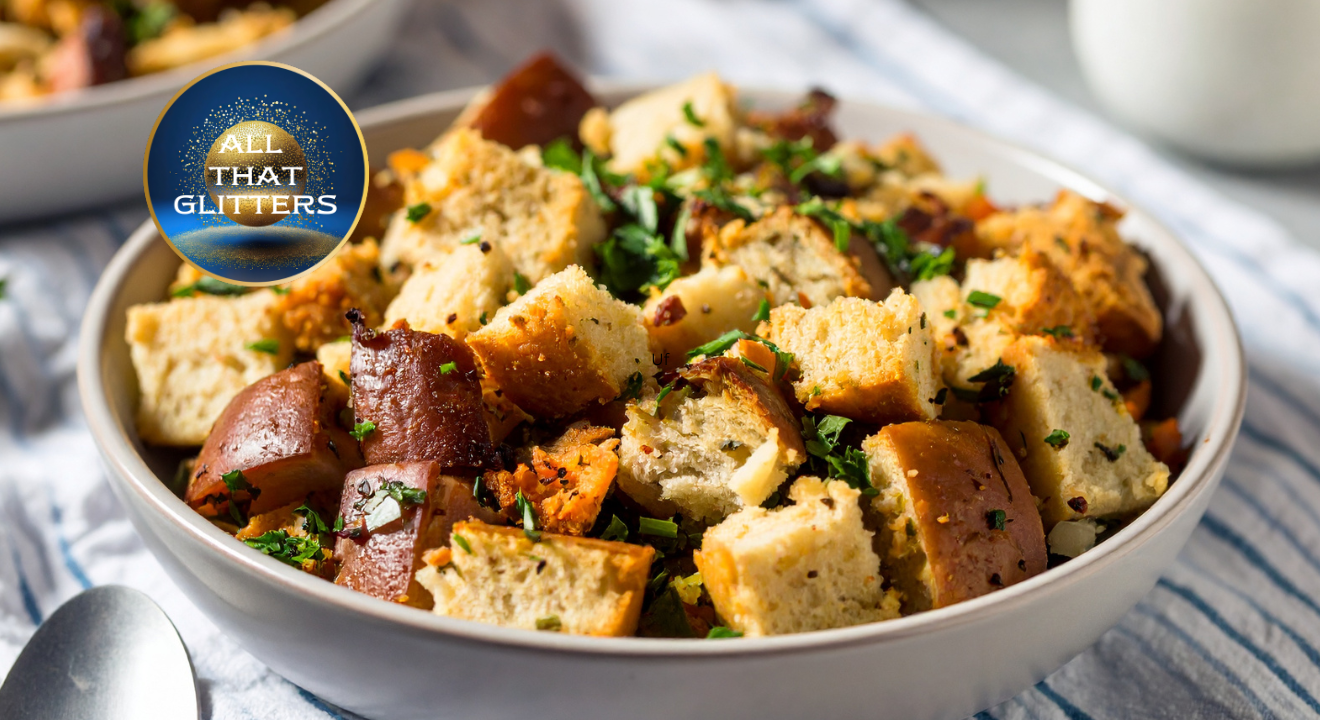This Year’s Thanksgiving Star: Sourdough Stuffing

Why This Year’s Star Thanksgiving Dish Might Be . . . Sourdough Stuffing
If you’ve noticed more friends swapping starter tips and photos of their sourdough loaves, you’re not alone—it seems like we’re in the era of homemade sourdough. And as Thanksgiving approaches, all that tangy, crusty bread is finding its moment in a dish that’s already beloved: stuffing.
For years, surveys have shown that stuffing consistently ranks as the favorite Thanksgiving side dish.
It’s nostalgic, comforting, and endlessly customizable. Now, add sourdough to the mix, and something magical happens. The natural tang of the bread brings brightness, the chewy interior soaks up broth beautifully, and the crust adds crunchy texture you just can’t get from a store-bought loaf or bagged stuffing mix.
Whether you’re a seasoned baker with a lively starter on your counter or someone who just tried (or purchased) their first loaf, sourdough stuffing is the perfect way to put your bread to delicious use. It feels classic yet modern, and is ideal for impressing guests or simply enjoying a cozy holiday meal.
This is my wife's recipe, adapted from Ina Garten, Thomas Keller, and Half Baked Harvest. Enjoy!
Ingredients
1 whole loaf of sourdough bread, cut or torn into 1-inch cubes (about 10 cups)
1 medium yellow or sweet onion, finely chopped
3 stalks celery, finely chopped
4 tablespoons unsalted butter
3 cloves garlic, finely minced
1 tablespoon fresh thyme leaves (or 1 teaspoon dried thyme)
1 teaspoon salt, plus more to taste
1 cup grated Parmesan cheese, divided
2½ cups low-sodium chicken or vegetable broth
1 large egg, beaten
2 tablespoons chopped fresh parsley for garnish
Directions
Begin by preheating your oven to 350°F (175°C). Spread the torn sourdough cubes evenly on a large baking sheet. Toast them in the oven for about 20 minutes, or until the edges are lightly golden and crisp. Stir halfway through to ensure even toasting. When golden, remove the cubes from the oven and let them cool.
In a large skillet, melt the butter over medium heat. Add the chopped onion and celery, cooking until softened, translucent, and fragrant, usually about 8-10 minutes. Stir in the minced garlic and cook for another minute, just until the garlic releases its aroma.
Sprinkle in the thyme, sage, salt, and pepper, stirring thoroughly to coat the vegetables in the butter and herbs.
Transfer the toasted sourdough cubes to a large mixing bowl. Pour the sautéed vegetable mixture over the bread and toss gently to combine. Ensure each cube gets coated with a touch of butter and herbs for maximum flavor, yet avoid overhandling.
Sprinkle ½ cup of grated Parmesan cheese into the bowl, reserving the remaining ½ cup for topping. Slowly pour in the broth while gently mixing. The goal is to moisten the bread without soaking it, so each cube should feel slightly damp (not wet) and still hold its shape, and no fluid should collect at the bottom of the bowl.
Once the mixture has cooled slightly, pour in the beaten egg and mix until everything is evenly combined. The egg will help bind the stuffing and give it a cohesive texture when baked. (Note: using an egg is optional.)
Lightly grease a 9×13-inch baking dish with butter or non-stick spray. Spread the stuffing mixture evenly into the dish and sprinkle the remaining ½ cup of Parmesan over the top.
Cover the dish with foil and bake for 25 minutes. Then, remove the foil and continue baking for another 20–25 minutes, or until the top is golden brown and crisp while the center remains soft and flavorful.
Let the stuffing cool for 5–10 minutes before serving. Sprinkle with chopped fresh parsley for a touch of color and freshness.
Helpful Tips
For best results, use day-old sourdough bread. Fresh bread tends to get soggy too quickly.
You can prepare the stuffing mixture a day in advance and refrigerate it, then bake it fresh before serving.
Try swapping Parmesan for Asiago or Pecorino Romano for a stronger, more robust taste.
Optional: Sausage: If you like to add sausage to your stuffing, simply brown loose sausage in a separate pan, and add to this recipe after you add the herbs and vegetables.
